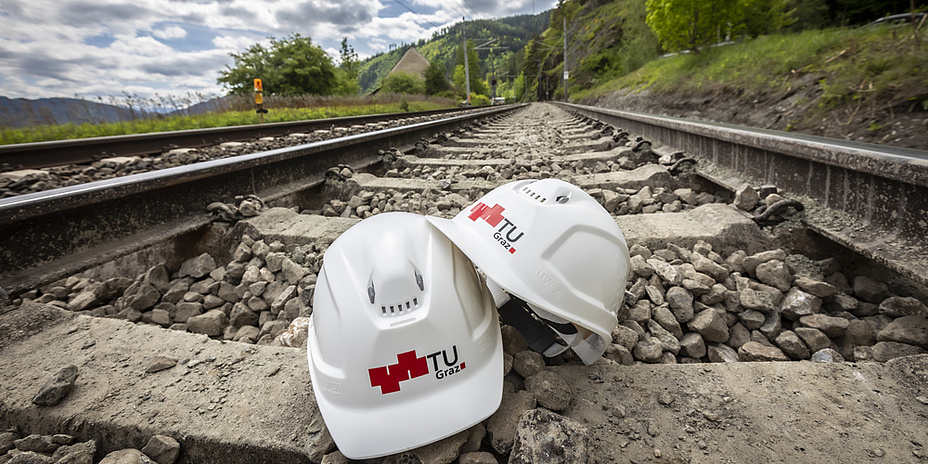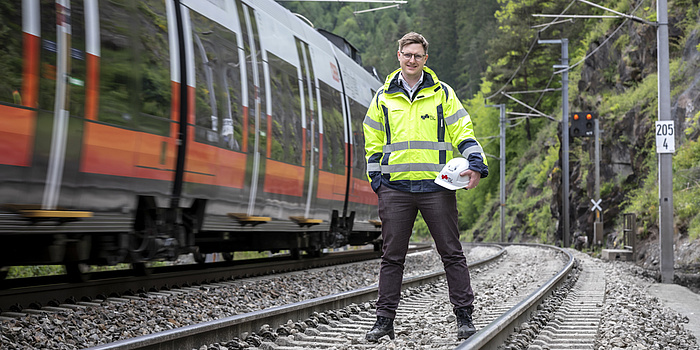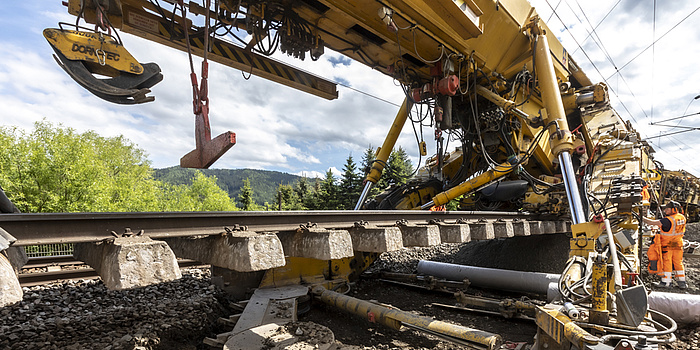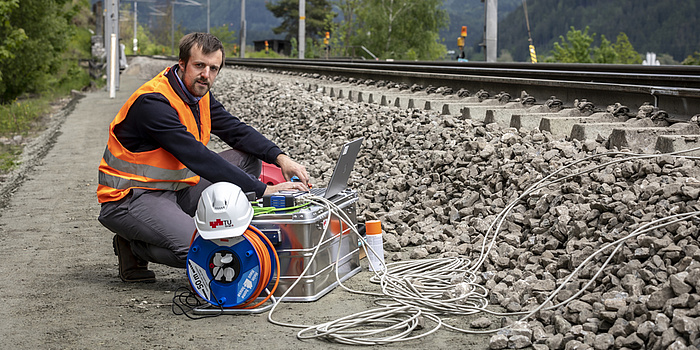On the Right Track: Railway Research at TU Graz

You could say that Austria is on the right track as far as its railway network is concerned. The need to promote sustainable and environmentally friendly forms of mobility, in view of the challenges posed by climate change, means that rail travel is becoming a more attractive part of the transportation mix, resulting in booming demand for both passenger and freight trains. TU Graz has also responded to this trend – the Research Cluster Railway Systems, which is intended to intensify collaboration between TU Graz institutes involved in railway-related research, as well as rail operators, industry, and research companies, was officially launched in mid-2021. We take a look at the work of the TU Graz research institutes that focus on rail travel.
The Research Cluster Railway Systems combines the research expertise of TU Graz, voestalpine, Austrian Federal Railways (ÖBB), Siemens Mobility Austria and Virtual Vehicle. The focus is on rail vehicle technology, railway infrastructure and rail operations. For further information on the cluster’s launch, a press release entitled “Railway System: Styria as International Centre of Research & Innovation” is available on our website.
Railways – an eco-friendly piece in the giant mobility jigsaw
Ever since it was established in the 1960s, the Institute of Railway Engineering and Transport Economy – which is now headed by Peter Veit – has taken a holistic view of the railway system as a form of mobility in its research. Forget about tinkering with locomotives or new rail tracks; instead, the institute places a strong emphasis on the economic and environmental sustainability of new rail lines and existing routes (life cycle costs and life cycle assessment), the potential for optimising maintenance (data analytics and predictive maintenance), and railways as part of a sustainable mobility chain. Besides main lines with high levels of traffic, research also looks at regional railways, which – according to the researchers – are relatively well developed in Austria. But they go on to point out that covering the costs of operating these important links between people’s homes and main railway routes is all but impossible. Digitalisation, modernisation and boosting the appeal of rail travel are the order of the day – co-modality is the new buzzword.

Matthias Landgraf in his (research) element. © Lunghammer – TU Graz
“Nowadays, it’s no longer a matter of switching entirely from one means of transport – like cars – to another, such as rail,” explains Deputy Head of Institute Stefan Marschnig. “Among the younger generation, attitudes are changing. The type of vehicle they use to travel from A to B isn’t important. The main thing is that it’s convenient and fast.” Both now and in the future, the main priority will be transforming railway stations into mobility hubs, complete with cycle parking spaces, e-vehicle charging points and/or good bus connections, and ideally a car-sharing station as well. “Changing between the different modes of transport needs to be quick and smooth, and through-ticketing is a must,” comments Matthias Landgraf, a researcher at the institute, outlining the key requirements for the future. “We also need to pay particular attention to safety and comfort in order to encourage people to switch to rail travel.”
Stefan Marschnig thinks that trains have clear advantages compared with cars: “I wouldn’t have the time to travel to Vienna by car for a meeting. But on the train I can make good use of my time; if I go by car, I just end up wasting a few hours.”
I wouldn’t have the time to travel to Vienna by car for a meeting. But on the train I can make good use of my time; if I go by car, I just end up wasting a few hours.
Fossil-free Track Work
In addition to assessing and carrying out calculations on rail routes, the institute is looking into energy-efficient rail network maintenance. In a project titled Fossil-free Track Work, researchers are trying to find ways to operate the drive units of heavy track-construction machinery, which is used to repair and renew railway lines, without using fossil fuels, making them more environmentally friendly. The construction and maintenance equipment used on rail networks is in a league of its own: these machines can be hundreds of metres long, they operate continuously and can perform several tasks at once, for example renewing the track substructure. They are also diesel-powered. When it comes to operating and maintenance, these highly specialised machines are very resource-intensive – and just like all components in the rail system, they are designed to last a lifetime. “You can’t just try to pinpoint a very specific innovation. As long as there are no alternative drive systems for these construction vehicles, it’s more important to deploy existing equipment as efficiently as possible, keeping resource consumption to a minimum. Sending diesel-guzzling track construction vehicles across the country willy-nilly comes at a high price in all sorts of different ways, and it is out of keeping with rail travel’s green image,” says Matthias Landgraf.

In future, the track-laying machines are to be operated in an environmentally friendly manner and without fossil fuels. © Lunghammer – TU Graz
Total systemic costs of ownership and environmental costs
Another key factor in the eco-friendliness of rolling stock is its impact on track infrastructure. “In the past, price was the number one consideration when it came to acquiring new rail vehicles,” Marschnig points out. “Nobody paid attention to the infrastructure damage caused by cheap – in some cases excessively cheap – vehicles, which in turn results in high costs.” With this in mind, over the past few years the institute has developed a method for allocating infrastructure costs to rail vehicles. As a result, these can be factored into vehicle procurement processes. However, this is only possible if route pricing (tolls) takes cost differentials into account. In future, it will be essential to consider environmental impacts when purchasing rolling stock and infrastructure components. The institute is also working on a calculation method that adds these cost elements to price quotations, which allows for the award of contracts in line with the best-bid principle, while also taking environmental aspects into account. The aim is to also integrate impacts on society resulting from the production of raw materials and similar products into the calculation.
Lightweight designs in railway construction
“The railway sector isn’t the first that you would usually associate with lightweight construction,” says Peter Brunnhofer with a smile. He heads the vibration testing centre at the Institute of Structural Durability and Railway Technology, based at Campus Inffeldgasse. The facility assesses the strength and longevity of train components and bogies. “Of course, steel still plays a central role in our work – carbon and other lightweight construction materials are not so well suited for use in safety-critical components, which need to withstand the 30-40 years of heavy-duty, day-to-day operations that trains are designed for.” Nevertheless, building lighter bogies is a vital consideration. The lower the weight of the vehicle, the less strain it places on railway infrastructure and the greater the volume of freight it can carry.
Besides lightweight construction, the main priority is automating component monitoring and optimising maintenance intervals.
In view of the increasing importance of railways, a few months ago the existing working group was spun off from the Institute of Machine Components and Methods of Development and set up as the newly established Institute of Structural Durability and Railway Technology. Martin Leitner is the head of the new institute. He also underlines the growing importance of looking at the system as a whole, and not just at individual components. “Besides lightweight construction, the main priority is automating component monitoring and optimising maintenance intervals,” Leitner explains. As part of a long-standing collaboration with industrial company Siemens Mobility, the institute has developed a lightweight wheelset axle with an integrated monitoring system. There is excess pressure inside the axle, so if it ruptures and the pressure drops as air escapes, the system sends an alarm signal. “A crack does not necessarily lead directly to a critical malfunction, but it needs to be monitored so that it can be rectified straight away or during routine maintenance,” Leitner adds. “The goal is to move away from specified maintenance intervals and towards ad hoc repairs and targeted maintenance planning.”
Simulations and digital twins – key factors in innovation
Innovations have been an important factor in the railway sector for years, according to Peter Brunnhofer. But he adds: “Making prototypes would be too expensive for us, so that’s why we focus on digital twins.” The institute is working with this kind of simulation to gain as realistic a picture as possible of the effect that a new material or other changes have on a vehicle. Experiments are not performed on volume-produced components until the optimisation process has been completed.
New developments as well as existing systems are analysed on the large test bed at Campus Inffeldgasse, where comprehensive servohydraulic tests can be performed on individual components or complete assemblies. Almost anything is possible, from static tensile tests and cyclical fatigue testing to endurance tests with over 10 million load cycles. “In this way we can realistically simulate the damage that occurs over 30 to 40 years of operation in a short space of time.”
We can realistically simulate the damage that occurs over 30 to 40 years of operation in a short space of time.
The Virtual Vehicle centre of expertise at the TU Graz Campus – another member of the Research Cluster Railway Systems – also specialises in simulations and digital twins. Focusing primarily on the automotive industry, the centre has been carrying out research into simulation methods for the best part of 20 years – and now the rail sector is also reaping considerable benefits from its work. Especially in the rail industry, it is not possible to implement all innovations immediately, so simulations play a fundamental role in decision making on the design of bogie and vehicle components.
Railway infrastructure design
A brand-new addition is TU Graz’s Institute of Railway Infrastructure Design and a chair of the same name. The chair holder and Head of Institute is Ferdinand Pospischil. He also emphasises the importance of taking a holistic view of rail systems. As reflected in its name, the institute focuses primarily on rail infrastructure – in other words the tracks, ballast bed, sleepers, rails and the interplay between them.
“The core question we address is how vehicles and infrastructure influence each other,” says Pospischil. “Above all, we want to consider improvements of the upper structure and to use measurement technology to carry out research directly on the rails. This is also thanks to our close collaboration with strong partners like ÖBB and other global market leaders from Austria, which is something we can’t take for granted.”
And there is another factor that is particularly important to the professor: “There is a staggering lack of specialists in our field. That’s not a problem just yet. Trains are running and we’re helping to improve them. But if we run out of experts, the railways will grind to a halt. So in my view, training tomorrow’s specialists is one of our core responsibilities.”

Ferdinand Pospischil during measuring work directly on the rail. © Lunghammer – TU Graz
This research area is anchored in the Field of Expertise “Sustainable Systems”, one of five strategic foci of TU Graz.
You can find more research news on Planet research. Monthly updates from the world of science at Graz University of Technology are available via the research newsletter TU Graz research monthly.
Kontakt
Institute of Railway Engineering and Transport Economy
Tel.: +43 316 873 6212
office.ebw@tugraz.at
Institute of Structural Durability and Railway Technology
Tel.: +43 316 873 1361
bst@tugraz.at
Institute of Railway Infrastructure Design
Tel.: +43 316 873 35081




